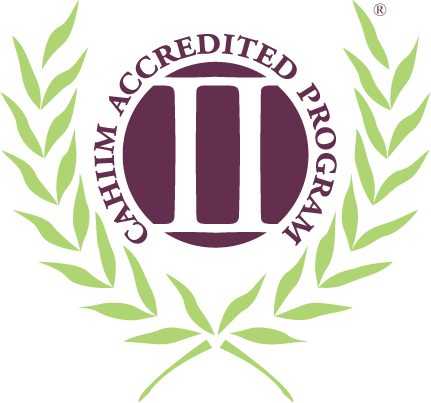Accreditation

As of 2024, SUNY Oswego’s BHI MS Program has achieved Accreditation Status with the Commission on Accreditation of Health Informatics and Information Management Education (CAHIIM).
All inquiries about the program’s accreditation status should be directed by mail to:
CAHIIM
200 East Randolph Street, Suite 5100
Chicago, IL 60601
Phone: (312) 235-3255
Email: [email protected]
Mission Statements
SUNY Oswego
SUNY Oswego contributes to the common good by lighting the path to wisdom and empowering every person in the college community to pursue a meaningful life as a productive, responsible member of society.
BHI MS Program
The mission of the Biomedical & Health Informatics Science Master’s (BHI MS) program is to educate students to effectively analyze, design, integrate, and manage health information systems using information technology for scientific inquiry, problem solving, and decision making, motivated by efforts to improve human health. Furthermore the program will strive at constantly forming students to the most innovative and advanced information technology for healthcare, health services, and health research in a fast-paced, connected, and ubiquitous environment. We believe that information science and technology improves and will continue to improve human health, and furthermore in a more global and inclusive manner than at any time in human history.
Program Educational Objectives
The goals of the proposed MS program are to prepare students for successful careers in Biomedical Informatics and health information-related disciplines or to the successful pursuit of research careers or post-graduate studies motivated by the goals to improve human health.
- Provide a broad overview of the methods and technologies supporting biomedical information systems, with a focus on intelligent (AI), ubiquitous, and data-intensive technology and devices.
- Emphasize theoretical (conceptual knowledge), as well as practical (embodied knowledge), foundations of health information systems.
- Emphasize the ability to synthesize and apply concepts in a professional setting.
- Prepare students with an in-depth competence in a specialization of the field that builds upon the program core.
We offer three tracks:
- Health Data Science
- Artificial Intelligence in Biomedicine
- Professional Biomedical Informatics
Student Outcomes
At completion of any of the three tracks, students will be qualified and encouraged to take certification exams in their specialty as is expected in biomedical disciplines. These certification exams include in particular the following, depending upon the respective track, the student’s educational background, and the student’s professional experience:
- AMIA Health Informatics Certification (AHIC)
- Certified Professional in Healthcare Information & Management Systems (CPHIMS) from the Healthcare and Information and Management Systems Society (HIMSS)
- Board Certification in Clinical Informatics from the American Board of Medical Specialties (ABMS)
- Informatics Nursing from the American Nurses Credentialing Center (ANCC)
- Certified Associate in Healthcare Information & Management Systems (CAHIMS) from HIMSS
- Other certification exams in biomedical informatics they may choose to take
Program Informational Measures
Time to Degree Completion
- Full-time students: 19.5 months (average) (less than two years)
- Part-time students: 28.9 months (average) (more than two years)
Figures are based on all available data since program start.
Retention (2023–24)
- Retention rate: 89.87%
- Attrition rate: 10.13%
- Retention for full-time students is almost perfect
Graduation
- Overall graduation rate for 2022–23: 77%
- Not final; includes part-time, full-time, and on-site students.
- Many part-time students are continuing studies.
- Full-time, in-person graduation rate = 100%.
- Final figures for 2023–24 not yet available.
Employment Outcomes
- 2023–24 Exit Survey: 100% of those seeking employment were employed before or within 3 months of graduation. (One student not seeking employment due to personal reasons; response rate = 5/34; additional outcomes confirmed via personal contacts/social media.)
- 2021–22 Alumni Survey: 100% employed within 6 months of graduation. (Response rate = 7/32 or 22%.)
Student Acceptance, Enrollment & Graduation
Table 1. Student acceptance and enrollment figures
| Academic Year | Fall Total Enrollments | Graduated | Accepted / Cond. Accepted | Enrolled |
|---|---|---|---|---|
| Spring 2017 | n/a | 1 | 5 | 5 |
| 2017–18 | 17 | 1 | 14 | 14 |
| 2018–19 | 23 | 3 | 19 | 14 |
| 2019–20 | 49 | 5 | 56 | 30 |
| 2020–21 | 63 | 15 | 64 | 43 |
| 2021–22 | 60 | 24 | 67 | 29 |
| 2022–23 | 58 | 16 | 86 | 29 |
| 2023–24 | 79 | 34 | 81 | 47 |